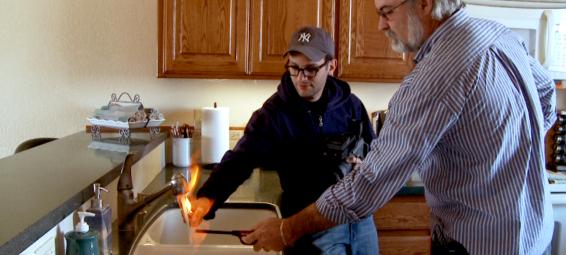You need to see Gasland if, like me, before seeing the film the word natural gas conjured up the image of Tommy Lee Jones before it did visions of water catching on fire, horses losing their hair, or brain lesions. Gasland is a documentary road movie that begins in Pennsylvania after the filmmaker, Josh Fox, receives an offer of around $100,000 for the mineral rights to his family’s land. He admits to not knowing much about natural gas production, so he starts to investigate. Beginning with his neighbors in Pennsylvania, Fox portrays himself as a reluctant detective of natural gas production and the harmful effect it seems to be having on the environment and the lives of people who live near wells.
That journey takes him across the United States, focusing specifically on Colorado, Wyoming, and Texas, where the gas production industry is most mature and widespread. What he finds is truly terrifying. In order to extract natural gas from the large shale depositories that cover vast portions of the country, water along with a hairy list of nasty chemicals (including frequent chemical movie stars like hydrochloric acid and arsenic) are forced into the ground, fracturing rock and allowing natural gas to escape. As a side effect, Fox finds that natural gas is sometimes released erratically, contaminating drinking water supplies or releasing into the atmosphere. A large part of Fox’s film consists of the filmmaker cataloging various catastrophes that follow in the wake of gas production, including natural gas bubbling through creeks, flammable water in kitchen faucets, sick and mutated animals, exploding wells, and polluted air in Wyoming that is worse than Los Angeles. There are stories of brain damage, cancer, asthma, and other health ailments, and on drilling sites he finds open sludge pits that seep toxic chemicals into the ground and other crude industrial practices.
On his way home to Pennsylvania, Fox travels through Texas, and speaks with then-SMU professor (now regional director for the EPA) Al Armendariz, who explains that air pollution related to natural gas production in Fort Worth accounts for more pollution in the atmosphere above Dallas-Fort Worth than automobiles. Than Armendariz has Fox use an infrared camera to look at a seemingly benign tank, the kind of white cylinders we drive by all the time in North Texas, revealing billowing toxins pouring out of the top of the container.
The problem with much of the evidence Fox uncovers is that it is anecdotal — scary, baffling, and utterly convincing, but circumstantial nonetheless. This gets at why his subjects feel so frustrated and helpless: they are portrayed as David up against a Goliath, but they are not allowed to use any stones. In one of the best scenes in the film, Fox finally sits down with someone who is involved in the natural gas debate from a regulatory perspective, an official with the Pennsylvania environmental commission. Fox tries to corner him on the many dangers of gas drilling, and the official dismisses the concerns, backing the competency of his staff for sorting out problems when they occur, and defensively admitting that natural gas is not a perfect energy solution. It is a bureaucratic brushoff that is both understandable and infuriating.
Fox does not fail at getting at the true scope of the catastrophic environmental damage that natural gas drilling could produce. If the harmful side effects are as prevalent as the cases he encounters, in which the impact is sudden and pervading (one Wyoming man tells of the water in his sole water supply, a well, turning black overnight) than what will be the outcome when drilling moves into the Delaware River Basin, the largest unfiltered water supply in the world that provides water to New York City, Philadelphia, New Jersey, and Delaware?






